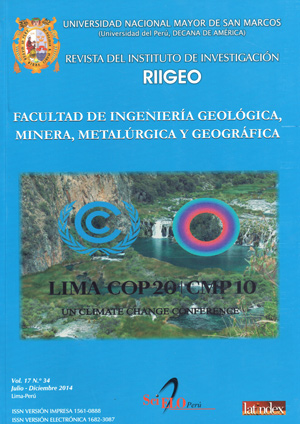Press selection and optimization of filter clothes for concentrates, tailings and sludge neutralization
DOI:
https://doi.org/10.15381/iigeo.v17i34.11395Keywords:
Blinding, Filter Clothes, Filter Press, Permeability, Filtration´s Performance, CAPEX (Capital Cost), OPEX (Operation Cost)Abstract
The current paper has as target to study the selection´s criteria and sizing of filter press, also, the variables and design´s parameters that influence the proper performance of filtration applied to slurry concentrates, tailings and sludge neutralization. In summary, the importance of CAPEX and OPEX when deciding to use a particular filter press. The filtering performance of concentrates and tailings in concentrator operations, also in neutralization in water treatment mine plants, can be evaluated from different points of view depending on the requirement of the operation, for example, you can say that a system filtration has acceptable performance if desired moisture percentage in the shortest possible cycle time, with the least amount of solids in the filtrate is obtained. Within this, it is essential to evaluate the efficiency of the filter clothes, plates, hydraulic system at the end of the filtration cycle. Similarly, the performance of the filter media exhibits a pattern that is related to the number of cycles, sieve analysis, slurry density, percent solids, and generally the quality and structure of the media. Thus, the clothes can be mechanically damaged by the abrasive. Another main reason that affects the performance of filtration is called Blinding effect. This paper will discuss this phenomenon too.Downloads
Published
Issue
Section
License
Copyright (c) 2014 Jorge Ventosilla

This work is licensed under a Creative Commons Attribution-NonCommercial-ShareAlike 4.0 International License.
AUTHORS RETAIN THEIR RIGHTS:
a. Authors retain their trade mark rights and patent, and also on any process or procedure described in the article.
b. Authors retain their right to share, copy, distribute, perform and publicly communicate their article (eg, to place their article in an institutional repository or publish it in a book), with an acknowledgment of its initial publication in the Rev. Inst. investig. Fac. minas metal cienc. geogr.
c. Authors retain theirs right to make a subsequent publication of their work, to use the article or any part thereof (eg a compilation of his papers, lecture notes, thesis, or a book), always indicating the source of publication (the originator of the work, journal, volume, number and date).






